The frontier regiment of Texas, in 1863, was again reorganized. During the preceding year Lt. Obenchain had been killed, and the confederate States refused to muster the frontier regiment into Confederate Service, for the reason that the regiment contained only nine companies instead of ten as required by Military regulations. As a consequence, February 11, 1863, the frontier regiment was reorganized, and the same material composing the original regiment was mustered into a new regiment. James E. McCord became Colonel; R.B. (Buck) Barry, Lt. Colonel; W.I. Alexander, Major. This new organization contained the required ten companies and as before was stationed at intervals of about one day's journey from the red River to the Rio Grande, for the purpose of protecting the West Texas frontier. The 6th of March, 1863, an Act was approved and passed recognizing the new organization and eight hundred thousand dollars appropriated to defray the regimental expenses. But not until the first of March, 1864 was this regiment, a part of the Confederacy. It belonged entirely to the State of Texas, and duly organized under her laws.
The various military troops were constantly changing their personnel. But on the 24th of December, 1862, before the new organization, Company A was under the command of Capt. James M. Hunter, and stationed at Fort Davis. Under the new organization, however, Thomas Rabb became Captain.
Company B. was under the command of John Lawson, and stationed at camp Verda. T.P. McCall was first Lieutenant and T.P. Adams and R.A. Harper second lieutenants.
Company C was commanded by J. Ward and stationed at Camp Brunson in May and June, 1863. S.G. Thompson also served as Captain of Company C, and Henry Ward as its first Lieutenant. W.P. Campbell and Charles Lindsay, second Lieutenants.
Company D was commanded by John T. Rowland as Captain, and S.J. Chapman was first lieutenant. W.D. Hoard, and James R. Giddens, second lieutenant. G.W. Campbell also served as second lieutenant in Company D, which was stationed at Red River station in the county of Montague.
Company E was commended by M.B. Lloyd and stationed at Camp Salmon, W.R. Chase was first lieutenant of this company, and B.F. Weeks, W.B. Burley, Geo. A. O'Brien, and J.J. Stockbridge, served as second lieutenants, but not all at the same time.
Company F was commanded by Captain H. P. Edgar, and stationed at Camp Dix. W.H. Cochran was first lieutenant. A.B. Hutchinson and J. Franks, second lieutenants.
Company G was commanded by Captain Newt White and stationed at Weatherford during February, May, and June of 1863. The company was also stationed at Fort Belknap during the same year. L.P. Strong was first lieutenant and W.R. Peveler, W.W. Willett and J.R. Carpenter, second lieutenants.
Company H was commanded by Captain R.M. Whitesides, and stationed at Camp Cooper during September and October of 1863. W.W. Hickey was first lieutenant and J.M. Brooks, John P. Hamilton, and John Clark second lieutenants.
Company I was commanded by Captain J.J. Callan and stationed at Camp Colorado in November and December 1863. Then T.C. Wright was first lieutenant and I.M. Chandler, and I.H. Christman, second lieutenants.
Company K was commanded by Captain W.G. O'Brien, and stationed at Camp San Saba. J.M. Wood was first lieutenant and James McDowell and R.H. Flipping second lieutenants. This completed the tenth company necessary to conform to the military regulations of the Confederate States of America.
These companies were constantly changing from place to place, and as a rule, each subdivided into two or more commands stationed about one day's journey from each other. In this way, no less than twenty camps extended from the Red River to the Rio Grande. Each day a patrol of about six men was sent from one camp to the next for the purpose of ascertaining whether or not Indians had passed from the northwest and west into the settlements. And in this way the frontier was patrolled daily from the Red River to the Rio Grande. This patrol duty became commonly known as "Pataroll Duty" among the members of the frontier regiment. Many of the surviving members of this military organization today, commonly speak of "Pataroll Duty."
Ref: Information for this section was gathered directly from old files in War Department, Washington, D.C. Adjutant General's office, Austin; Texas Almanacs 1885, and from pioneers.
The above story is from the book, The West Texas Frontier, by Joseph Carroll McConnell. Frontier Protection - 1861
An act was passed February 7, 1861, providing that each of the frontier counties be authorized to organize a company of minutemen not to exceed forty in number, rank and file, for the purpose of protecting the frontier. Each member of such company was required to keep himself furnished with a suitable horse, guns and necessary provisions.
December 21, 1861, an act was approved providing for the raising of a regiment of rangers to protect the northern and western frontier of Texas. Such rangers were required to equip themselves in the same manner mentioned in the preceding paragraph, and then were further required to enlist for a period of twelve months. The requisite number of men were required to be raised as follows: One company in the counties of Clay, Montague, Cook, and Wise; one company in the counties of Young, Jack, Palo Pinto and Parker; one company in the counties of Stephens, Eastland, Erath, and Bosque; one company in the counties of Coryell, Hamilton, and Lampasas, Comanche, and Brown; one company in the counties of San Saba, Mason, Llano and Burnet; one company in the counties of Blanco, Bandera, Medina, and Uvalde; one company in the counties of Frio, Atascosa, Liveoak, Karnes, and Bee; one company in the counties of El Paso, and Presidio, and one company was authorized to be raised in any section of the State designated by the Governor. The last company, which was the tenth, was never organized. So the regiment consisted of nine companies. The act provided that these frontier troops be stationed in detachments of not less than twenty-five in each camp, along the frontier from the Red River to the Rio Grande, and then down the latter stream to its mouth.
Nine companies, lettered from A to I, were organized in January of 1862, and James M. Norris of Gatesville made Colonel of the regiments. The companies were located and commanded as follows: Company A, Rio Grande Station, Thomas Rabb, Captain; Company B, Camp Salmon, John Salmon, Captain; Company C, Camp Breckenridge, Allen Brunson, Captain; Company D, Camp Verde, Charles De Montel, Captain; Company E, Camp San Saba, N.D. McMillan, Captain; Company F, Camp Llano, H.T. Davis, Captain; Company G, Camp Collier, F.M. Collier, Captain; Company H, Camp Nueces, J.J. Dix, Captain; Company I, Camp Belknap, J.J. Cureton, Captain.
Note: Before writing this section, the author personally studied the dusty files in the War Department at Washington, where a large number of Confederate records are preserved; also studied records on file in the Adjutant General's Office in Austin, and interviewed surviving old timers, many of whom were in this regiment. Further reviewed records on file in the Texas State Library. Also found much valuable material in a set of bulletins: Official Records of the War of the Rebellion, and Texas Almanacs for the early and middle sixties.
The above story is from the book, The West Texas Frontier, by
Joseph Carroll McConnell.
Frontier Regiment, 1862-1863
Newly elected governor Francis Richard Lubbock shouldered the responsibility of providing protection to the frontier after the withdrawal of Van Dorn and McCulloch's Rifles. He placed Col. James M. Norris in command supported by Lt. Col. Alfred J. Obenchain and Maj. James Ebenezer McCord. Ranger Sowell's account of patrolling with Goodnight illustrates the men's disdain for Norris and deadly hatred of Obenchain. McCord took over command in February, 1863 and located his headquarters at Camp Colorado, wisely relying on Lt. Col. James (Buck) Barry to coordinate the defenses north to the Red River.
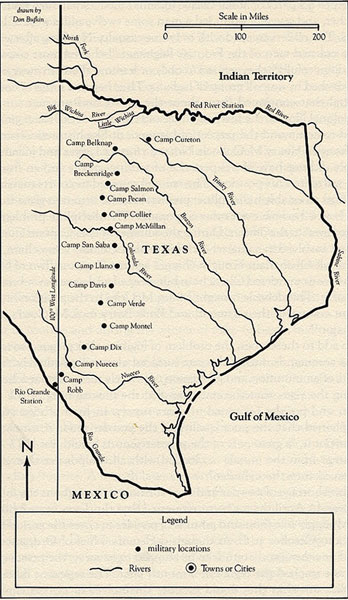
Eighteen camps were occupied for use of the regiment. Part of A. Brunson's Company A deployed in northeastern Wichita County, not far from the Big Wichita, with the rest probably at the old Texas Mounted Rifles camp at the junction of Beaver Creek and the Big Wichita River, in southwestern Wichita County. This company soon shifted eastward to Red River Station, in Montague County. Part of Capt. Jack Cureton's Company B was posted at Camp Cureton, where the Gainesville-Fort Belknap road crossed the West Fork of the Trinity River, in Archer County, with the rest of the company at Camp Belknap near Fort Belknap. Half of Capt. John Salmon's Company C was stationed at Camp Breckenridge, in Stephens County; the other half at Camp Salmon near Sloan's Ranch on the East Fork of Hubbard's Creek, in northeastern Callahan County. Half of Capt. T.N. Collier's Company D was posted at Camp Pecan, where the Camp Cooper-Camp Colorado Road crossed Pecan Bayou, in Callahan County; the other half at Camp Collier at Vaughn's Springs in Clear Creek, in Brown County. Half of Capt. N.D. McMillan's Company E was stationed at Camp McMillan near Hall's Spring at the headwaters of Richland Creek, in San Saba County; the other half at Camp San Saba, where the Camp Colorado-Fort Mason Road crossed the San Saba River.
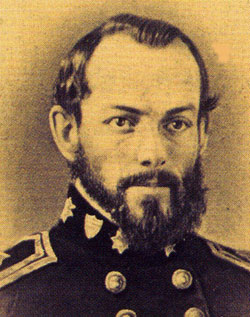
General E. Kirby Smith
Center for American History
In August, 1863, Confederate General Kirby Smith ordered General John Bankhead Magruder to place General Henry McCulloch in overall command of the northern frontier.
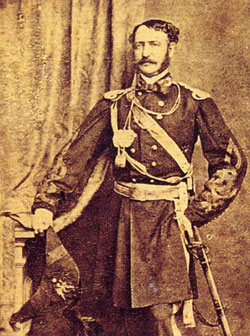
Confederate Gen. John Bankhead Magruder
Texas State Library and Archives Commission
Major William Quayle, regimental commander at Pea Ridge and Corinth and State Senator in 1863, took command of the first frontier district in January, 1864. His right-hand was George B. Erath, veteran of John H. Moore's Ranger Company of 1835, Battle of San Jacinto, 1836, and extensive Ranger duties through the 1840s. North Texas had long been a haven for deserters and those avoiding conscription primarily because of the general perception that there was no war in California and the Cross Timbers provided good camping and game in preparation for the long trek west.

John R. Baylor
Picture from the book, Blood & Treasure, by Donald S. Frazier
McCulloch managed to capture, or forced to surrender, a large number of these traitors, the best of which were allowed to join what was called the Brush Battalion, originally under the command of John R. Baylor. Baylor soon left for Virginia to serve in the Confederate Legislature and was replaced by Maj. John R. Diamond.
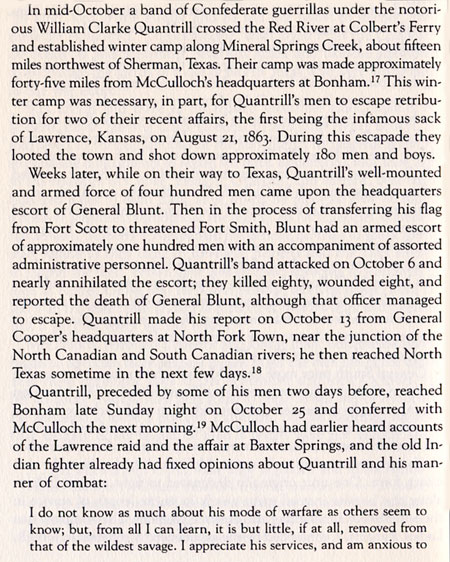
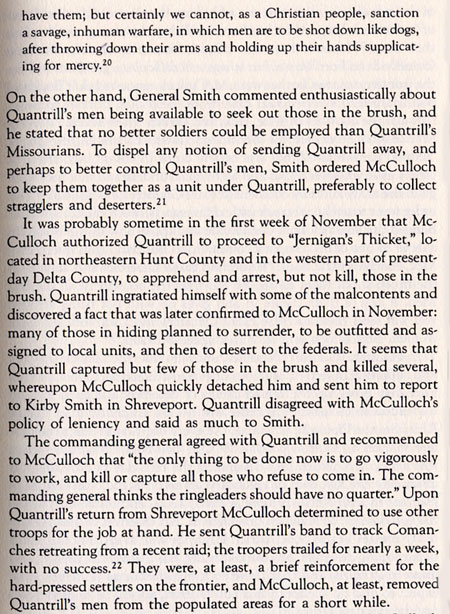
Through the summer, reports of large concentrations of hostile Indians, west of the reservations, demanded the Texans' attention but no punitive strikes could be mounted due to a shortage of manpower. Buck Barry's command was ordered to the Gulf Coast. Raids increased through the fall, climaxing into the big raid in Montague and Cooke Counties during December, 1863.
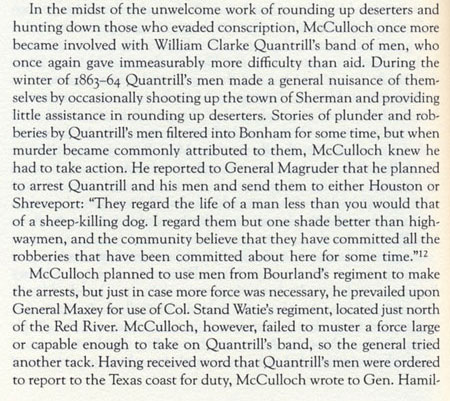
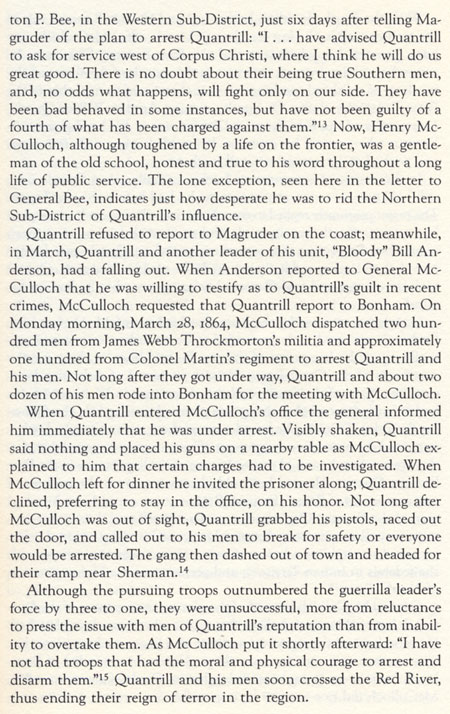
Early in his command, Quayle was surprised to be approached by a subordinate, Captain Luckey and asked if he could speak "off the record." He then described a large population, not only in the community but in the ranks, of Union sympathizers. With border commander Bourland's help, a dependable spy named L.L. Harris from Bonham secretly surveyed the situation arming Quayle with the knowledge he needed to sort out the renegades.
The following account is from the book Frontier Defense in the Civil War by David Paul Smith:
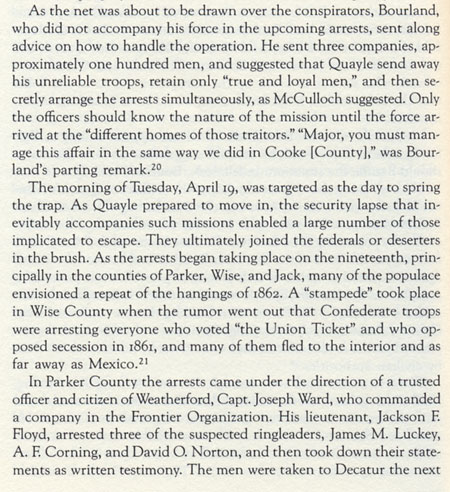
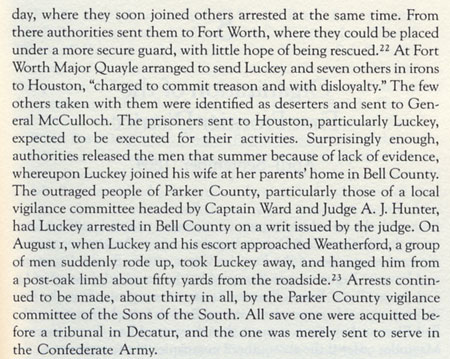
This is also from the above-mentioned book:
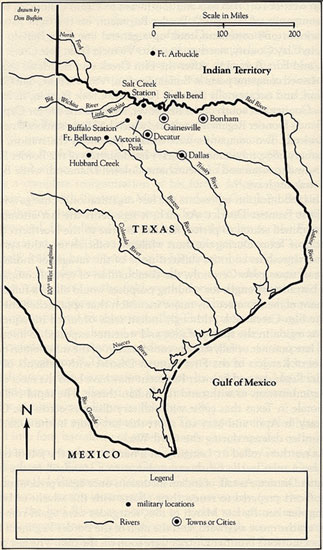
By mid-summer, 1864, Bourland's companies and commanders were located at the folowing stations: Company A, Capt. C.L. Roff, Camp Simons (southwest of Fort Arbuckle); Company B, Capt. James J. Diamond, Fort Arbuckle; Company C, Capt. A.J. Nicholson, Fort Arbuckle; Company D, Capt. A.B. White, Fort Belknap; Company E, Capt. F.M. Totty, Victoria Peak (west-central Montague County); Company F, Capt. S.F. Mains, Fort Belknap; Company G, Capt. S.P.C. Patton, Gainesville; Company H, Capt. James Moore, Hubbard Creek (eastern Shackelford County); Company I, Capt. J.B. Anderson, Buffalo Station (Buffalo Springs, southeast Clay County); and, Company K, Capt. William C. McKaney, Camp Twitty (near Spanish Fort, just east of Red River Station). Captain Roff soon became major of the regiment, in charge of the small battalion at Fort Belknap, while Lt. Col. John R. Diamond commanded the battalion that operated out of the Fort Arbuckle vicinity. Regimental quartermaster was Capt. William C. Twitty.
A few determined settlers stayed on the frontier. Most forted up and the Rangers and soldiers increased their vigilance. Nothing could have prepared them for the size or ferocity of the October, 1864, Elm Creek Raid in Young County.
In late March, 1865, Capt. George Bible Pickett led thirty men northwest from Decatur to join Col. Diamond and Captains Earhart, Shoemaker and Shannon in pursuit of deserters.

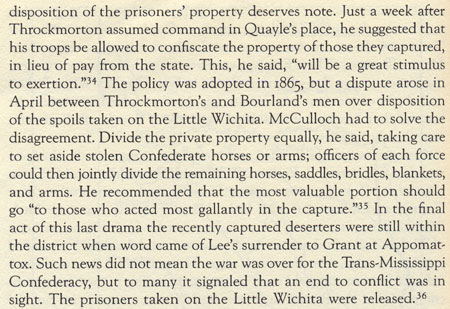
Frontier Protection - 1863
The frontier regiment of Texas, in 1863, was again reorganized. During the preceding year Lt. Obenchain had been killed, and the confederate States refused to muster the frontier regiment into Confederate Service, for the reason that the regiment contained only nine companies instead of ten as required by Military regulations. As a consequence, February 11, 1863, the frontier regiment was reorganized, and the same material composing the original regiment was mustered into a new regiment. James E. McCord became Colonel; R.B. (Buck) Barry, Lt. Colonel; W.I. Alexander, Major. This new organization contained the required ten companies and as before was stationed at intervals of about one day's journey from the red River to the Rio Grande, for the purpose of protecting the West Texas frontier. The 6th of March, 1863, an Act was approved and passed recognizing the new organization and eight hundred thousand dollars appropriated to defray the regimental expenses. But not until the first of March, 1864 was this regiment, a part of the Confederacy. It belonged entirely to the State of Texas, and duly organized under her laws.
The various military troops were constantly changing their personnel. But on the 24th of December, 1862, before the new organization, Company A was under the command of Capt. James M. Hunter, and stationed at Fort Davis. Under the new organization, however, Thomas Rabb became Captain.
Company B. was under the command of John Lawson, and stationed at camp Verda. T.P. McCall was first Lieutenant and T.P. Adams and R.A. Harper second lieutenants.
Company C was commanded by J. Ward and stationed at Camp Brunson in May and June, 1863. S. G. Thompson also served as Captain of Company C, and Henry Ward as its first Lieutenant. W.P. Campbell and Charles Lindsay, second Lieutenants.
Company D was commanded by John T. Rowland as Captain, and S.J. Chapman was first lieutenant. W.D. Hoard, and James R. Giddens, second lieutenant. G.W. Campbell also served as second lieutenant in Company D, which was stationed at Red River station in the county of Montague.
Company E was commended by M.B. Lloyd and stationed at Camp Salmon, W. R. Chase was first lieutenant of this company, and B.F. Weeks, W.B. Burley, Geo. A. O'Brien, and J.J. Stockbridge, served as second lieutenants, but not all at the same time.
Company F was commanded by Captain H.P. Edgar, and stationed at Camp Dix. W.H. Cochran was first lieutenant. A.B. Hutchinson and J. Franks, second lieutenants.
Company G was commanded by Captain Newt White and stationed at Weatherford during February, May, and June of 1863. The company was also stationed at Fort Belknap during the same year. L. P. Strong was first lieutenant and W.R. Peveler, W.W. Willett and J.R. Carpenter, second lieutenants.
Company H was commanded by Captain R.M. Whitesides, and stationed at Camp Cooper during September and October of 1863. W.W. Hickey was first lieutenant and J.M. Brooks, John P. Hamilton, and John Clark second lieutenants.
Company I was commanded by Captain J.J. Callan and stationed at Camp Colorado in November and December 1863. Then T.C. Wright was first lieutenant and I.M. Chandler, and I.H. Christman, second lieutenants.
Company K was commanded by Captain W.G. O'Brien, and stationed at Camp San Saba. J.M. Wood was first lieutenant and James McDowell and R.H. Flipping second lieutenants. This completed the tenth company necessary to conform to the military regulations of the Confederate States of America.
These companies were constantly changing from place to place, and as a rule, each subdivided into two or more commands stationed about one day's journey from each other. In this way, no less than twenty camps extended from the Red River to the Rio Grande. Each day a patrol of about six men was sent from one camp to the next for the purpose of ascertaining whether or not Indians had passed from the northwest and west into the settlements. And in this way the frontier was patrolled daily from the Red River to the Rio Grande. This patrol duty became commonly known as "Pataroll Duty" among the members of the frontier regiment. Many of the surviving members of this military organization today, commonly speak of "Pataroll Duty."
Ref: Information for this section was gathered directly from old files in War Department, Washington, D.C. Adjutant General's office, Austin; Texas Almanacs 1885, and from pioneers.
The above story is from the book, The West Texas Frontier, by Joseph Carroll McConnell.
Reorganization of Frontier Forces and Extension of Frontier Protection
December 15, 1863, an act was approved providing for additional frontier protection, and the transfer of frontier regiments to Confederate service. Sections I and II of said act were as follows:
"Section I. Be it enacted by the State Legislature of the State of Texas, that all persons liable to due military duty, who are at the passage of this act bonafide citizens of the following line of counties, and all counties lying north and west of said line, to wit; Wise, Parker, Cooke, that part of Johnson west of the Belknap and Fort Graham road, Bosque Coryell, Lampasas, Burnet, Blanco, Bandera, Medina, Kendall, Atascosa, Live Oak, McMullen, La Salle, Dimmit, and Maverick, shall be enrolled and organized into companies not less than twenty-five, nor more than sixty-five men rank, and file.
"Section II. That it shall be the duty of the governor, immediately after the passage of this act, to cause the counties designated in the preceding section to be divided into three districts, as equally in territory and population as may be; in each of which district he shall appoint a suitable person, with the rank and role of major of cavalry, who shall be the ranking officer of the district to which he is appointed, and which he is appointed, and which officer shall be charged with the organization of the men subject to duty in this section."
January 6, 1864, the governor divided the territory into three district divisions, and in record time, the districts were organized, commanded and policed as follows, to wit:
FIRST DISTRICT
Commanded by Brig. Gen. J.W. Throckmorton and Maj. Wm. Quayle 2nd in command
Wise County. Capt. B.B. Haney's company, 70 men; J.M. Hanks' 66; J.B. Earhart's 58; W.B. Shoemake's 66; G.B. Pickett's 50; Total 310
Parker County. Capt. P. Witt's Company, 61; J. Caldwell's 59; Joseph Ward's 68; M. Upton's 58; Dav. Yary's 60. Total 306.
Cooke County. Capt. J.O. Hill's Company 62; T.F. Whally's 56; Jas. Graham's 54; C. Potter's 51. Total 223.
Montague County. Capt. J.P. Guinn's Company 50; S. Shannon's 49. Total 99.
Jaik County. Capt. T.F. Robert's Company, 54; E. E. Orrick's 49. Total 103.
Palo Pinto County. Capt. J. H. Dillahunty's Company, 55; Wm. C. Clayton's 58; Lt. . J.C. Lowey's, 41. Total 154.
Young County. Capt. Wm. R. Peveler's Company 52; Lt. Chas. Newhous, 31; Capt. Casteel's, 45. Total 128.
Stephens County. Capt. J.J. Cureton's Company. 56; J.W. Curtis, 57. Total 113
Total force of District 1436.
SECOND DISTRICT
Commanded by Maj. Geo G. Erath
Johnson County, Capt. J.M. McReynold's Company, 52; W.A. Gathey's, 60. Total 112
Lampasas County. Capt. M.J. Scott's Company, 51; W.B. Pace's 65, Total 116.
Comanche County. Capt. Jas. Cunningham's Company, 65; Lt. Wm. F. Robinson's 49. Total 114
Bosque County. Capt. Wm. R. Barne's Company, 55; S.S. Totten's, 65. Total 120.0
Erath County. Capt. J.B. Martin's Company, Wm. H. Culver's 67; N.M. Gillentin's 64; E.B. Pugh's 64; Lt. A.S. McCammant's 27. Total 279.
Brown County. Capt. D.H. Mosley's Company, 65; D. Skaggs', 57; N.C. Duncan's, 66. Total 188.
Coryell County. Capt. J.K. Shipman's Company, 65; G. Graham's, 67; Lt. G.F. Adams' 25. Total 157.
San Sabe County. Capt. J.H. Brown's Company, 51; W.R. Woods', 64. Total 116.
Coleman County. Capt. J. Mullen's Company, 65.
Hamilton County. Capt. J.M. Rice's Company, 64.
McCullock County. Capt. D. Barton's Company, 40.
Mason County. Capt. A. Hunter's Company, 65; H. Biberstien's, 52. Total 117.
Eastland County. Lt. Singleton Gilbert's Company, 41.
THIRD DISTRICT
Commanded by Brig. Gen. J.D. McAdoo; Maj. James M. Hunter, 2nd in Com.
Burnet County. Capt. Chris. Dorbandt's Company, 56; Jno. Barton's 65; Jas. P. Magill's, 65; G.C. Bittick's, 65. Total 251.
Kerr County. Lt. D.H. Farr's Company, 28
Llano County. Capt. J.S. Bourland's Company, 65; Lt. F. Breazeall's, 41. Total 150.
Gillespie County. Capt. E. Krauskoff's Company 63; Wm. S. Wahrman's 62; Lt. P. Waldrup's, 25. Total 106.
Blanco County. Lt. Hudson's Company, 39.
Bandera County. Capt. B. Mitchell's Company, 53.
Medina County. Capt. Geo. Robbin's Company, 56; Lt. A. Weber's, 22. Total 78
Kendall County. Capt. Wm. E. Jones' Company, 65.
Karnes County. Lt. J. King's company, 45.
Uvalde County. Lt. J. Watkin's Company, 44.
Bee County. Lt. J. Hyne's, 36
Frio County. Capt. William's Company, 71.
Live Oak County. Capt. N. Gussett's Company, 71.
Atascosa County. Capt. J. Tom's Company, 65; Lt. J.A. Durand's, 28. Total 98
Other Counties: Capt. Walhersdoff's command, 100.
Total Force of District, 1211
D.B. Culbetson, Col. of Cavalry and Adjutant and Inspector General, State Military strength of the three districts, October 1, 1864, was 4176 men. These troops were in addition to the Frontier Regiment, commanded by Col. James E. McCord. After their organization, there was a decrease in Indian Depredations. But it was late in 1864, before the full strength of these forces became effective on the frontier. As a consequence of this heavy frontier organization, the depredations during 1865 were only about 60% of the usual average for the several preceding years.
The above story is from the book, The West Texas Frontier, by Joseph Carroll McConnell.
Frontier Protection, and Change in Government Policy
The long-needed change in the government's policy toward the reservation Indians, and wild tribes, was finally realized during 1874. The government, in a measure, abandoned their peace policy toward the Indians, and waged several decisive campaigns in the West. These campaigns, which really should have been made before the Civil War, needless to say, brought about a radical change in frontier conditions. Practically all the northwestern Indians, who had hundreds of human scalps hanging in their shields, and who had been preying on the settlements so long, were subdued and forced on the reservations. But of course, it required a long time to bring about the long-needed relief.
During 1873, there were only about six engagements between the United States' soldiers and Indians, reported from Texas. But during 1874, no less than twenty-four engagements were reported, and most of these were on a major scale.
Ref. Rept. of the Sec. of War, for 1874; Heightman's Historical Register and Dictionary of the United States Army: Personal Recollections of Gen. Nelson A. Miles; List of Battles, Actions, etc., published by the U.S. Govt., (1902); Also interviewed many early frontiersmen, who were familiar with frontier conditions at that time.
The above story is from the book, The West Texas Frontier, by Joseph Carroll McConnell. |












